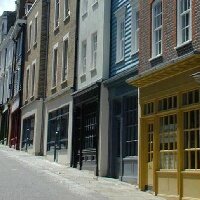Historic Environment


Nearly all the historic places in England earn their own keep - not just our stately homes, castles and cathedrals, but also our city quarters, parks, historic towns and village high streets that have more local significance.
Background
There are around half a million listed buildings in England; the vast bulk of these are in some form of use which generates sufficient resources for their repair and maintenance without any support from public funds. The majority are in private hands and include private dwellings, railway stations, pubs, commercial premises, farm buildings, and many other uses, including public sector ones such as courts, town halls, and schools. Uses for standing ancient monuments tend to be more limited; but the majority of scheduled sites are below ground and have a range of economic activities, principally farming & tourism, taking place on and around them. Conservation areas vary in wealth, but even the poorest have many viable pockets within them. Registered parks and gardens also often accommodate revenue earning activities. Around these particularly significant buildings and sites is a wider landscape and townscape of historic character, which provides both a setting and contributes in its own right to tourism and other economic generators.
Why is funding sometimes necessary?
So it is the exception rather than the rule for the historic environment to require public intervention and sometimes subsidy to ensure its conservation. Why do these exceptions occur? The starting point is often failure by the owner. A building or site capable of economic use will fall into a state of neglect and disrepair because the owner fails to carry out repairs and maintenance in good time or at all. This may be for a number of reasons including lack of knowledge, reluctance to spend money, shortage of finance or, in a few cases, deliberate neglect to try and get rid of what is seen as a liability or to clear a site for development.
The answer in many cases is not public funding but a change of ownership. Where a building is capable of viable long-term use, it should be repaired and put into that use as quickly as possible. Local authorities should intervene early to keep costs low. Can another owner make a go of it without public subsidy? If so the aim must be to get a transfer of ownership, if necessary through enforcement action. A back-to-back agreement for disposal after acquisition by the local authority will mean that costs are limited to those relating to enforcement and often the mere threat of this is sufficient to persuade an owner to sell.
But sometimes the market cannot secure a sustainable future for a building or site. Most commonly this is due to a conservation deficit. A building or site falls into disrepair. Eventually it reaches a state where the scale and cost of repairs outweighs the final value of the building or site. This problem is often geographically linked; a building or site that is viable in London or the South East may not be so in the North or far West of the country. What sources of funding are available in these circumstances?
Option Appraisal
The first thing to consider is the potential of the building or site itself to generate income or capital. Is any revenue-generating use possible through use or re-use, possibly after repair and alteration? Are there land or ancillary buildings which could be sold off or provide for enabling development without significantly damaging the historic significance of the building or site? Are there any legally enforceable obligations on the existing owner? Would the existing owner contribute some money to be rid of the responsibility of owning the building or site?
Funding
Once the income or capital generating potential and the cost of repairs and any necessary alterations or development is known, the size of the conservation deficit can be assessed and other sources of funding can be considered. The key here is to look as widely as possible at the range of outcomes that can be secured by the repair of the building or site, and to consider whether they can be matched with public sources of funding. The Architectural Heritage Fund’s website Funding for Historic Buildings; A Directory of Sources is an excellent starting point. Possibilities include European and other regeneration funding either direct or through regional development agencies or English Partnerships. Also available is agri-environment and other funding for the countryside through DEFRA schemes, Housing Corporation funding for social housing, and funding from Lottery distributors such as Sport England and the Arts Council. English Heritage and the Heritage Lottery Fund are the two main sources of direct funding for the repair and conservation of historic buildings and sites. Compared with the HLF, funding from English Heritage is much more restricted in scale and is targeted primarily at the most important elements of the historic environment. There are other smaller but significant players such as the Architectural Heritage Fund. And some local authorities operate their own grant schemes.
Such funding is valuable in its own right to secure a sustainable future for a building or site. It may also attract match and partnership funding from other sources, as well as contributing to social and economic regeneration. You will also need to consider what management structure best suits the project you are proposing. Local authorities may choose to manage the project themselves, but it will usually be better to stand at arms length and to allow the project to be managed by another body. Where such a body is a charitable trust (for example a building preservation trust) there will be access to sources of funding not available to local authorities; for example charitable trusts and individual donations. By making use of volunteer workers of all kinds and sponsorship through the provision of materials or labour at cost, charities are very often capable of bringing down the overall cost of a project.
Sustainability
Finally, you will need to consider the long-term future of the building or site. Generally, where an appropriate use can be found for a building or site that will allow it to be self-supporting after repair and any necessary alteration, then this option should be adopted even if it means selling the building on. Where a use needing revenue support is proposed in these circumstances, the cost of providing that revenue support should not be seen or justified as part of the cost of conserving the building or site.
Some buildings or sites will always require public support. These will range from isolated non-economic structures such as market crosses, war memorials, statues or obelisks to major sites such as ruined castles or industrial works which can earn money as a visitor attraction, but not enough to cover the cost of operation or maintenance. The former can generally be managed with little in the way of cost implications; routine maintenance and quadrennial condition surveys are the main items and these will often be very small. When major repairs fall due, while there is no guarantee, the expectation must be that such structures will continue to be a priority for repair grant from EH.
The latter present the greatest challenge. There are few if any sources of long-term public or charitable funding for the revenue costs of such buildings and sites, although they may be a high priority for capital grants from EH and the HLF. This means that in practice they have to look to a charitably disposed private owner, or a public body such as the National Trust or a local authority for their future security.
Local authorities should adopt the same approach to historic buildings and sites in their own care. Regular maintenance will ensure that repair costs are kept low. Repairs should be tackled quickly rather than allowed to worsen. The operational use of buildings should be kept under review and those that are redundant should be disposed of into appropriate new uses quickly. Where buildings and sites are taken to secure their long-term future, proper consideration should be given to the scope for economic use and the need for continuing public support.
Further Advice
Further information on funding is available from this website, including English Heritage Grants.
Also of interest:
- The Architectural Heritage Fund: www.ahfund.org.uk
- Funds for Historic Buildings: www.ffhb.org.uk
- Heritage Lottery Fund: www.hlf.org.uk
- War Memorials Trust: War Memorials Trust
What's New?
-
The National Heritage List for England is now live on the English Heritage website.
-
Welcome to the HER21 page. This page offers access to the full suite of HER21 project reports.
